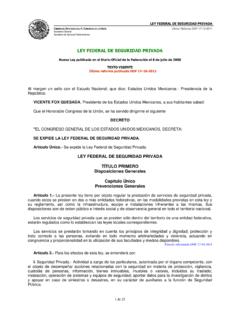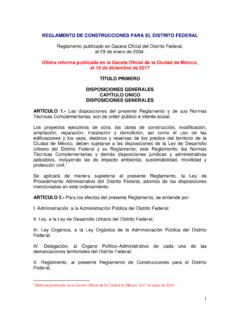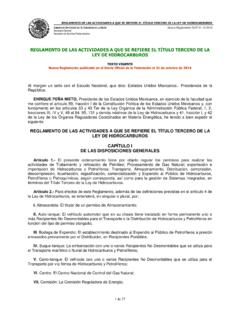Transcription of General Recommendations References
1 Alcohol & FlyingAlcohol & FlyingA DEADLY COMBINATIONYou are in controlFlying, while fun and exciting, is a precise, demanding, and unforgiving endeavor. Any factor that impairs the pilot s ability to perform the required tasks during the operation of an aircraft is an invitation for disaster. The use of alcohol is a significant self-imposed stress factor that should be eliminated from the cockpit. The ability to do so is strictly within the pilot s avoidanceIdeally, total avoidance of alcohol should be a key element observed by every pilot in planning or accomplishing a avoidance is as critical as developing a flight plan, a good preflight inspection, obeying ATC procedures, and avoiding severe of Transportation / federal aviation administration 14 CFR Part 121 - Antidrug and Alcohol Misuse Prevention Programs This rule amends the FAA regulations governing drug and alcohol testing to clarify that each person who performs a safety-sensitive function for a regulated employer by contract.
2 Including by subcontract at any tier, is subject to testing. These employees are removed from performing these functions if their breath alcohol concentration registers or greater on a required alcohol test, or if they otherwise use alcohol in violation of the rule. They are also temporarily removed from the performance of these functions if their breath alcohol concentration registers between - on a required alcohol employees performing safety-sensitive functions are required to submit to the following: post-accident tests, random tests, reasonable suspicion tests, return to duty tests, and follow-up Recommendations1.
3 As a minimum, adhere to all the guidelinesof 14 CFR Part : 8 hours from bottle to throttle do not fly while under the influence of alcohol do not fly while using any drug that mayadversely affect safety2. A more conservative approach is to wait 24 hoursfrom the last use of alcohol before flying. Thisis especially true if intoxication occurred or if youplan to fly IFR. Cold showers, drinking blackcoffee, or breathing 100% oxygen cannot speed upthe elimination of alcohol from the Consider the effects of a hangover. Eight hoursfrom bottle to throttle does not mean you arein the best physical condition to fly, or thatyour blood alcohol concentration is below thelegal Recognize the hazards of combining alcoholconsumption and Use good judgment.
4 Your life and the lives ofyour passengers are at risk if you drink and in mind that regulations alone are noguarantee that problems won t occur. It is farmore important for pilots to understand thenegative effects of alcohol and its deadly impacton flight Medical Standards and Certification, 14 CFR Pt. (2012).2. Alejandro Caro-Nu ez T, Chidester T. Literature Review andRecommendations Concerning Alcohol Tolerance Under Part , DC: Office of Aerospace Medicine; 2018. DOT/FAA/AM-18 Alcohol Facts and Statistics. NIH National Institute on AlcoholAbuse and Alcoholism Web Site. June 2017. Accessed October 20, Dubowski KM.
5 Absorption, distribution and elimination ofalcohol: highway safety aspects. J Stud Alcohol. 1985;10:98 by Aerospace Medical Education Division, AAM-400 To obtain copies of this brochure online: contact: federal aviation AdministrationCivil Aerospace Medical Box 25082 Oklahoma City, OK 73125(405) 954-4831OK-18-1620 ALCOHOL USE IN AMERICA Over 50% of American adults consume alcohol. Per capita consumption is about 25 gallons per year. Alcoholic beverages are marketed in a v ariety of forms, with wine and beer being the most liked. Different alcoholic beverages have different concentrations of alcohol; however , their total alcohol content can be thesame.
6 F or example, a pint of beer contains as much alcohol as a 51/2 ounce glass of table wine. Therefor e, the notion that drinking low-concentration alcoholic bev erages is safer thandrinking hard liquor is erroneous. The total alcohol content of any alcoholic beverage canbe easily calculated using the following formula: Proof divided by 2 = percent pure beverages, used by many to unwind or relax, act as a social ice-breaker, a way to alter one s mood by decreasing inhibitions. Alcohol consumption is widely accepted, often providing the cornerstone of social gatherings and celebrations. Along with cigarettes, many adolescents associate the use of alcohol as a rite of passage into its use is prevalent and acceptable in our society, it should not come as a surprise that problems arise in the use of alcohol and the performance of safety-related activities, such as driving an automobile or flying an aircraft.
7 These problems are made worse by the common belief that accidents happen to other people, but not to me. There is a tendency to forget that flying an aircraft is a highly demanding cognitive and psychomotor task that takes place in an inhospitable environment where pilots are exposed to various sources of facts about alcohol It s a sedative, hypnotic, and addicting drug. Alcohol quickly impairs judgment and leads to behavior that can easily contribute to, or cause accidents. The erratic effects of alcohol Alcohol is rapidly absorbed from the stomach and small intestine, and transported by the blood throughout the body. Its toxic effects vary considerably from person to person, and is influenced by variables such as gender, body weight, rate of consumption (time), and total amount consumed.
8 The average, healthy person eliminates pure alcohol at a fairly constant rate. That is about 1/3 to 1/2 oz. of pure alcohol per hour. This is equivalent to the amount of pure alcohol contained in any of the popular drinks listed in Table 1. This rate of elimination of alcohol is relatively constant, regardless of the total amount of alcohol consumed. In other words, whether a person consumes a few or many drinks, the rate of elimination of alcohol from the body is essentially the same. Therefore, the more alcohol an individual consumes, the longer it takes the body to get rid of it. Even after complete elimination of all of the alcohol in the body, there are hangover effects that can last 48 to 72 hours following the last drink.
9 The majority of adverse effects produced by alcohol relate to the brain, eyes, and inner ear which are three crucial organs to a pilot. Brain effects include impaired reaction time, reasoning, judgment, and memory. Alcohol decreases the ability of the brain to make use of oxygen. This adverse effect can be magnified as a result of simultaneous exposure to altitude, characterized by a decreased partial pressure of oxygen. Visual symptoms include eye muscle imbalance, which leads to double vision and difficulty focusing. Inner ear effects include dizziness, and decreased hearing perception. If such other variables are added as sleep deprivation, fatigue, medication use, altitude hypoxia, or flying at night or in bad weather, the negative effects are significantly magnified.
10 Studies of how alcohol affects pilot performance Pilots have shown impairment in their ability to fly an ILS approach or to fly IFR, and even to perform routine VFR flight tasks while under the influence of alcohol, regardless of individual flying experience. The number of serious errors committed by pilots dramatically increases at or above concentrations of blood alcohol. This is not to say that problems don t occur below this value. Some studies have shown decrements in pilot performance with blood alcohol concentrations as low as the are dangerousA hangover effect, produced by alcoholic 1 beverages after the acute intoxication has worn off, may be just as dangerous as the intoxication itself.












